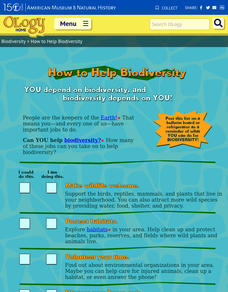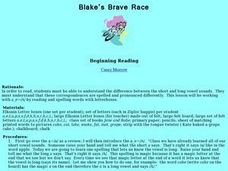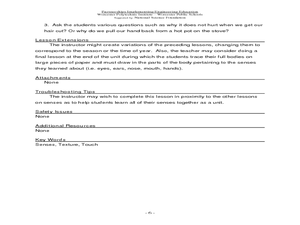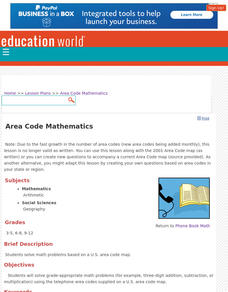American Museum of Natural History
How to Help Biodiversity
A resource provides a checklist of nine actions for pupils to take to do their part in supporting biodiversity. The list suggests more obvious actions such as supporting wildlife to less obvious ideas like learning about different...
Teach Engineering
Bouncing Balls
How high will it bounce? Groups determine the height different balls bounce off of different surfaces. By performing the necessary calculations, they determine the initial and final momentum of the balls. The included worksheet provides...
Teach Engineering
Tools and Equipment (Part 1)
Looking for the best inclined plane for the job? Groups calculate the theoretical mechanical advantage for four different inclined planes. They determine the actual mechanical advantage by measuring the amount of force needed for the...
Teach Engineering
Density Column Lab - Part 2
Groups suspend objects within layers of liquids to determine the densities of different liquids and compare them to the densities of objects calculated in Part 1. The groups then carefully test their calculations by layering the liquids...
Teach Engineering
Bone Density Math and Logarithm Introduction
What do logarithms have to do with bone density? Scholars learn that the equation for bone density includes logarithms. The majority of the third lesson of seven is devoted to logarithms and their properties.
Teach Engineering
Let's Get it There Fast
Are planes the best shipping method? Using maps, pupils determine the fastest mode of transportation between two cities. Given a list of items to ship, groups decide the best shipping method to finish the 18th segment of a 22-part unit.
Pala Software
MathBoard
Do you want to practice arithmetic skills from simple addition facts, to cubes and square roots, to solving one-step equations? Here is a great app for practicing and learning everything from arithmetic practice using integers to solving...
Curated OER
Modals
Verbs can be tricky, especially those modal verbs of probability. Take a look at a wonderful 16-page workbook that uses think-pair-share, critical thinking, skills practice, and discussion to assist learners in using the correct modal...
Curated OER
Project Yellow Bus
Students discover the uses of energy and the difference between renewable and nonrenewable resources. They participate in hands-on activities to help them explain the concept of energy.
Curated OER
Pandemic Flu
Young scholars review the difference between viruses and bacteria, and provide examples of illnesses that each can cause. To help students comprehend how quickly an influenza infection can spread, they perform an activity. They are...
Curated OER
Hypothesis Testing: Two Sample Tests
Students experiment and compare results of two populations. In this men and women populations lesson, students examine the difference in hand span for men and women. Students calculate a norm based on their results. Students complete...
Curated OER
Use(d) to
In this sorting worksheet, students sort ten sentences that have the word "use(d)" into three groups. Students are then asked to briefly explain the difference between each group on the lines provided.
Curated OER
Vertebrates
Students identify and describe five main groups of the Phylum Chordata. They discover that the Phylum Chordata is the vertebrates. Students identify the main difference between invertebrates and vertebrates. They read passages about...
Curated OER
Blake's Brave Race
Students distinguish the difference between the short and long vowel sounds. They practice correspondences that are spelled and pronounced differently working with a_e=/A/ vowel sounds. Elkonin Letter boxes and class set of books are...
Curated OER
Engineering the Senses
Students become aware of texture and the sense of touch. In this senses lesson, students become aware of their dominant hand. Students draw pictures using texture. Students describe a texture of an item in a mystery bag.
Curated OER
States of Matter
Student explore states of matter. In this science lesson plan, students define matter, identify the states of matter, tell about the properties of each state of matter, and demonstrate an understanding of the difference between a...
Curated OER
Lakes and Ponds
Students describe and recognize the difference between a lake and a pond. They name six ways in which a lake or pond can be formed. They describe the importance and act of evaporation on a waterway.
Curated OER
The Body Part of Cells
Eighth graders are introduced to cell organelles and their functions and the they define the differences between animal and plant cells. They write a paragraph explaining the difference between plant and animal cells and students...
Curated OER
Go Cough Up a Lung!
Third graders examine and identify the effects smoking has on the lungs. They view and discuss pictures of a smoker's lung and a healthy lung, and read and discuss an informational handout. Students then participate in an aerobic...
Helping with Math
Addition - Sums to 12
Addition practice worksheets are good to have on hand to add to homework packets. On this one, 30 single-digit vertical problems are arranged into six rows of five problems each. Add this to your library of tools for reinforcing addition...
Curated OER
Factoring Trinomials
Students factor trinomials using specific factoring methods. For this algebra lesson, students factor equations using the difference of squares and foiling. They play a game to enhance their understanding of factoring.
Curated OER
Electricity 2
Fifth graders build on what they already know and classify examples of electricity in their lives into two categories: static and current electricity. They explore the difference between static and current electricity and provide...
Curated OER
The Blues . Writing . Biographies/Profiles . The Soul of a Man
This lesson, focused on profile writing and its unique characteristics, considers the profiles developed in the film The Soul of a Man while also asking students to consider other profiles they are familiar with and to write some of...

























